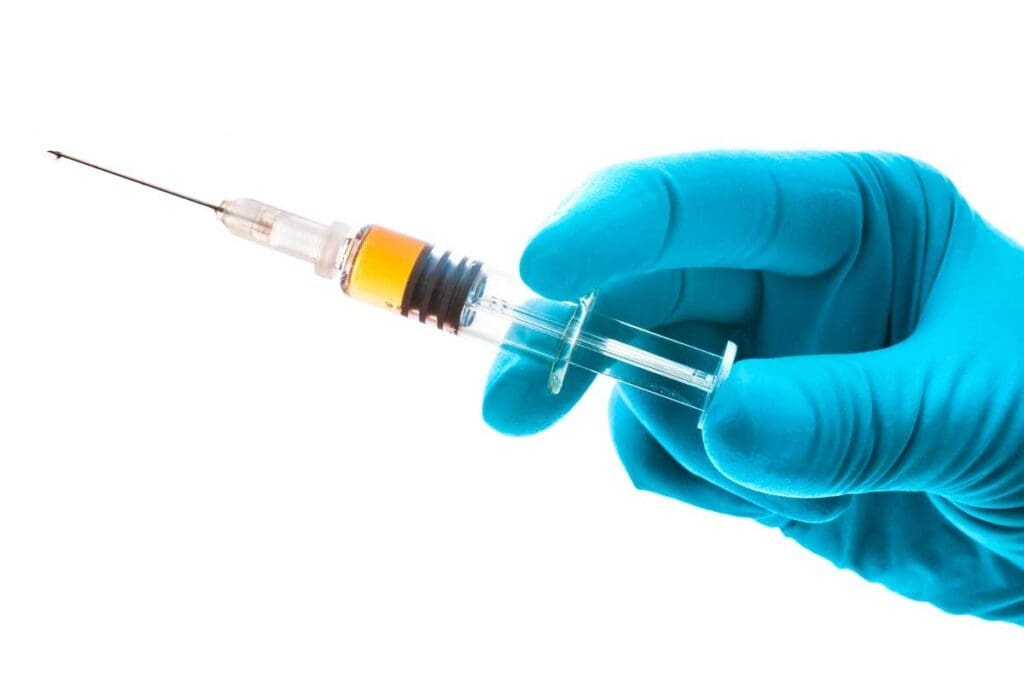Last Updated on November 17, 2025 by Ugurkan Demir
Enoxaparin injections, commonly referred to as shots for blood clots, are critical in stopping and treating blood clots. Enoxaparin is a low molecular weight heparin that acts by binding to antithrombin III, forming a complex that irreversibly inactivates clotting factor Xa, which reduces the blood’s ability to form clots. It has less potency against thrombin than unfractionated heparin but effectively prevents the formation and growth of clots like deep venous thrombosis and pulmonary embolism. Administered typically as a subcutaneous injection in the stomach, enoxaparin has a high bioavailability and starts working within hours. Due to its predictable action, it is widely used for both treatment and prevention of clotting disorders, with dosing adjusted according to patient risk and renal function. At Liv Hospital, using these shots ensures effective and safe management of clotting risks in patients.

Enoxaparin, also known by other names, comes from heparin. It’s approved by the FDA for many uses, like treating heart issues and blood clots in veins. We want to share the important facts about enoxaparin injections to help you understand its use.
Enoxaparin is a type of low molecular weight heparin. It’s often called a ‘blood thinner injection in the stomach’ or a ‘blood clot shot.’ We use it to stop and treat blood clots in deep veins and lungs. These conditions can be deadly if not treated properly.

Blood thinners, like enoxaparin, stop blood clots from forming. They are key for people at risk of DVT and PE, like after surgery or when you can’t move much. Enoxaparin works by boosting antithrombin III, which stops factor Xa from causing clots.
Enoxaparin is sold under names like Lovenox and Clexane. It’s also known as enoxaparin, enoxaparan, or enoxaprim, though these names vary. It comes in a solution for injection, given just under the skin in the belly.
| Common Name | Brand Name | Form |
| Enoxaparin | Lovenox, Clexane | Solution for Injection |
| Enoxapar | Variations of Lovenox | Solution for Injection |
| Enoxaparan | Generic versions | Solution for Injection |
Knowing the different names and forms of enoxaparin helps patients and doctors. It’s important to know the exact type and brand to ensure it’s used correctly. This helps avoid bad side effects.
Understanding how enoxaparin works is key to preventing and treating blood clots. Enoxaparin is a type of anticoagulant given as an injection in the abdomen. This blood thinner injection in the abdomen is designed to be painless and easy to do yourself.
Enoxaparin prevents and treats blood clots by interacting with specific proteins in the blood. It works by affecting the body’s clotting process.
Enoxaparin boosts the activity of antithrombin III, a protein in the blood that stops clotting. Antithrombin III is important for controlling blood coagulation. Enoxaparin’s interaction with it is key to its effect.
Enoxaparin’s effect comes from binding to antithrombin III. This makes it better at stopping factor Xa, a key part of clotting. By stopping factor Xa, enoxaparin helps prevent blood clots.

Here’s a summary of how enoxaparin’s mechanism compares to other anticoagulants:
| Anticoagulant | Mechanism of Action | Primary Use |
| Enoxaparin | Binding to antithrombin III, inhibiting factor Xa | Prevention and treatment of blood clots |
| Warfarin | Inhibiting vitamin K-dependent clotting factors | Long-term anticoagulation |
| Aspirin | Inhibiting platelet aggregation | Prevention of cardiovascular events |
Enoxaparin starts working quickly when given intravenously. Its peak effect is seen about 4 hours after being given under the skin. This fast action is important for preventing and treating blood clots.
We use enoxaparin sodium injection for several important reasons. It helps prevent Deep Vein Thrombosis (DVT) and treats blood clots. This anticoagulant is key in preventing and treating blood clot-related problems.
Enoxaparin sodium injection is approved by the FDA for DVT prevention in major surgery patients. Preventing DVT is vital because it can cause serious conditions like pulmonary embolism.
This medication also treats DVT and pulmonary embolism. It stops the blood clotting process, helping dissolve clots and preventing new ones. Effective treatment of blood clots helps avoid long-term damage to limbs and lungs.
Enoxaparin sodium injection is also used to prevent blood clots in heart attack patients. This shows its importance in managing heart conditions.
Blood thinner injections are often given in the stomach area. Enoxaparin, a common blood thinner, is given as a shot in the abdomen. This helps it work well to prevent blood clots.
The shot should be given in different spots on the stomach. This is to avoid any problems and make sure it works right.
Abdominal injections are chosen for good reasons. The fatty layer under the skin makes it easier to give shots. It’s also less likely to hit a muscle or nerve.
The stomach area is big, making it easy to switch where you give the shot. This helps avoid soreness and bruising.
When you give yourself a blood thinner shot, you need to do it right. Here’s how:
It’s important to follow these steps carefully. If you have any trouble or worries, talk to a healthcare provider.
| Injection Site Characteristics | Benefits |
| A relatively fatty layer under the skin | Easier subcutaneous injection |
| Less prone to muscle movement | Reduced risk of hitting a muscle or nerve |
| Large surface area | Easier rotation of injection sites |
Enoxaparin helps manage blood clots, but it’s important to know about side effects and precautions. Knowing these can help you stay safe while taking the medication.
People taking Enoxaparin might notice some common side effects. These include:
It’s essential to monitor these side effects closely and report any concerns to your healthcare provider.
While rare, there are serious complications with Enoxaparin. These include:
Recognizing these warning signs early can help prevent serious complications.
Enoxaparin can interact with other drugs, increasing side effects. It’s key to tell your doctor about all medications you’re taking, including:
Discussing your medication regimen with your healthcare provider can help minimize possible interactions.
Enoxaparin therapy is key in stopping and treating blood clots. These clots can be deadly if not treated. It’s shown to prevent deep vein thrombosis after surgery and treat blood clots in the legs and lungs.
It also helps prevent more problems after heart attacks. This makes enoxaparin very important for saving lives.
Enoxaparin works by stopping blood clots from forming. This lowers the chance of serious blood clot problems. Knowing how it works helps patients manage their health better.
It’s important to use enoxaparin correctly and know about possible side effects. This ensures it works well and safely. Following the right way to use it and knowing about side effects is key.
Healthcare teams use enoxaparin to improve patient care and lower blood clot risks. So, enoxaparin is a vital drug for preventing and treating blood clots.
Enoxaparin is used to prevent and treat deep vein thrombosis (DVT) and pulmonary embolism (PE). It also helps prevent blood clots after a heart attack.
Enoxaparin binds to antithrombin III. This stops factor Xa, a key part in blood clotting. It prevents clots from forming.
Abdominal injections are better because they help the medication absorb better. They also reduce bruising and discomfort.
To give yourself enoxaparin, pinch the skin first. Then, insert the needle at a 90-degree angle. Slowly inject the medication.
Common side effects include bruising, bleeding, and pain at the injection site. You might also feel headaches and fatigue.
Possible complications include bleeding disorders, low platelet count, and allergic reactions.
Yes, enoxaparin can interact with other drugs. This includes antiplatelet agents, NSAIDs, and other anticoagulants. Always talk to your doctor about your medications.
Enoxaparin sodium injection is used to prevent and treat blood clots. This includes DVT and PE.
Yes, enoxaparin is also known as enoxapar, enoxaparan, and enoxaprim. But its brand name is Lovenox.
Subscribe to our e-newsletter to stay informed about the latest innovations in the world of health and exclusive offers!